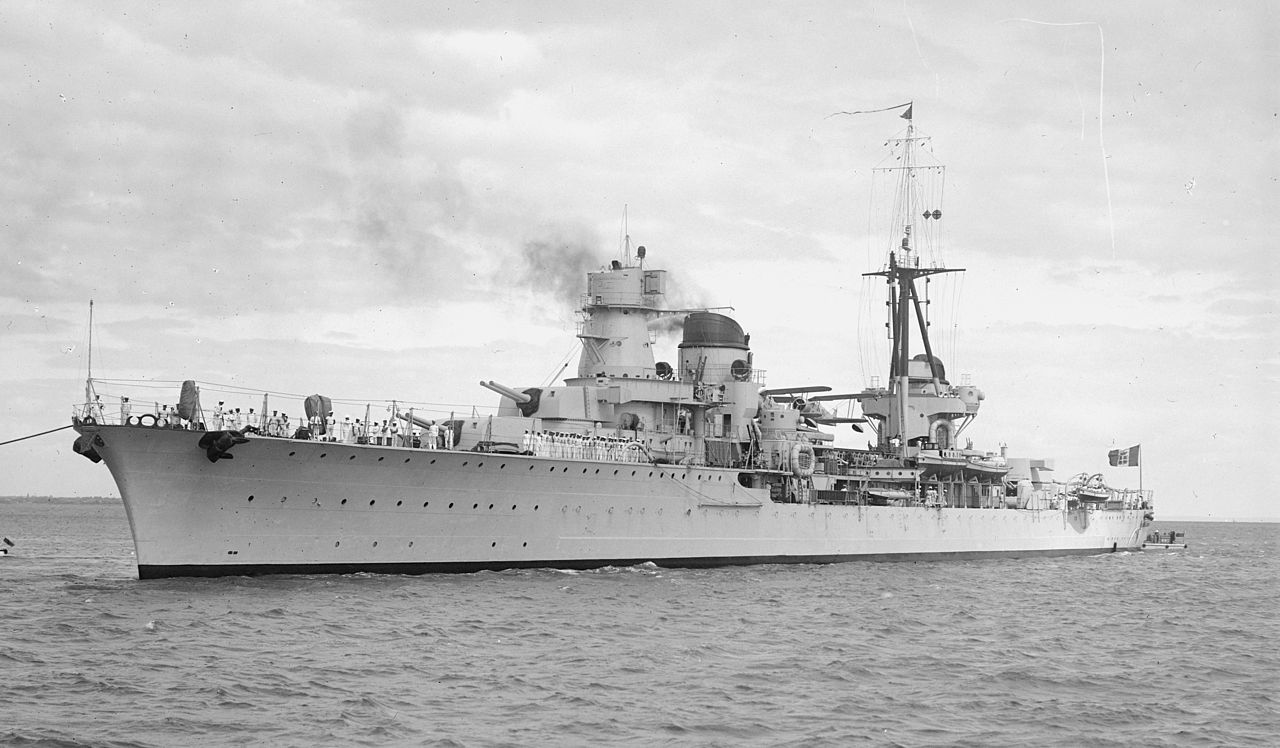
Transalpine Cruisers: Grace and speed under the eagle
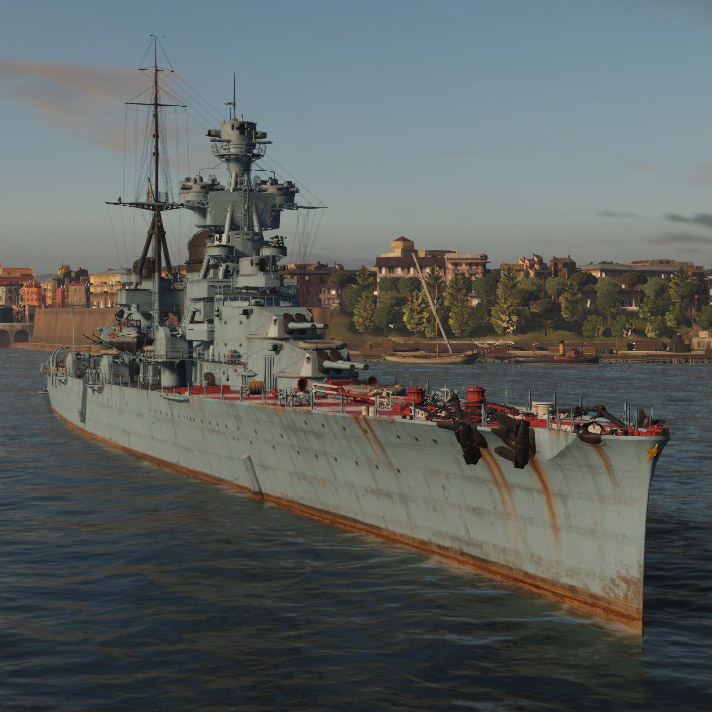
The Regia Marina surprised everyone, soon after the country was united in the 1880s by its unusual and powerful ships, made by famous naval engineers such as Benedetto Brin. Due to the isolation and weakness of the Austro-Hungarian Navy in an Adriatic under lock and key beyond the Otranto barrage, it was not seriously tested during WW1. Like France, she was caught by surprise by the dreadnought race and was in full transition, neglecting cruisers for a time and catching up at great cost. The irredentism and rise of Fascism only contributed to reinforce the image of a fleet made to built a colonial Empire in the Mediterranean, and later the affirmation of a “mare nostrum”. Mussolini dreams of grandeur were shattered by the Washington Treaty, imposing a tonnage that Italy was not in financial position to overcome anyway. Like the French Navy, the Marina modernized itself by sticking to an almost ship-for-ship basis with France, until WW2 erupted.

Author’s overview of Italian cruisers camouflages in WW2 – All cruisers. Work in progress.
This was especially true for Italian cruisers, more than any other topic. The match was even, with a slight advantage for Italy, then France, and Italy again in terms of cruisers, unit for unit. For example WW1 war reparation cruisers were about the same German-built ships and served as colonial cruisers. Modern cruisers were built in the 1920s through the famous ‘Condotierri’ superclass, through the need of countering French super-Destroyers.
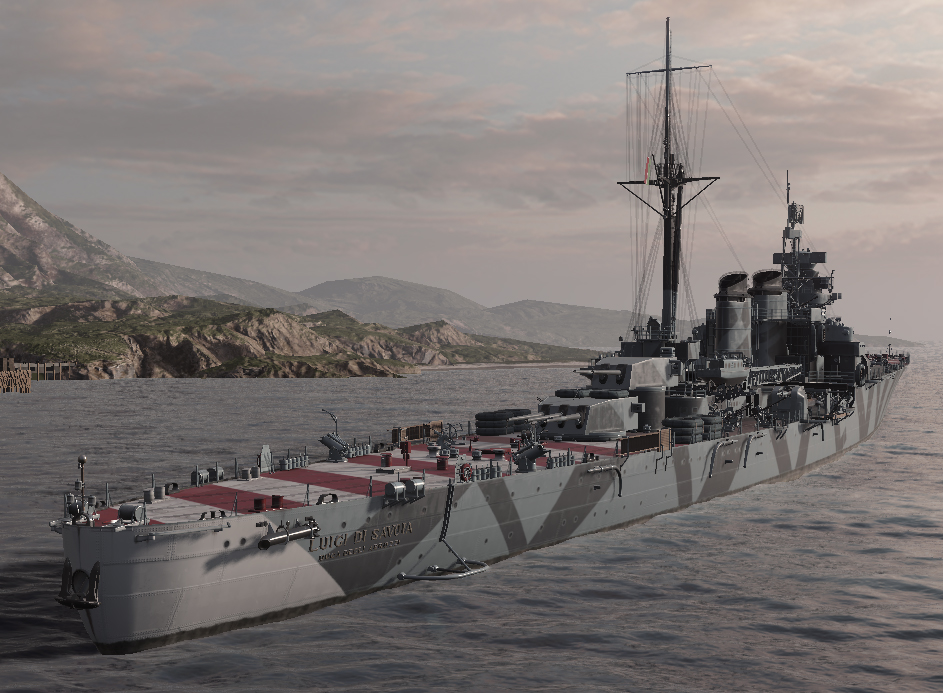
Italian light Cruiser Duca degli Abruzzi
Development of Italian cruisers
There were three distinctive steps in this evolution:
1-The “Condotierri” destroyer hunters: Guissano and Cardona classes.
2-The heavy cruiser era (with an evolution between the ‘tin-clad’ Trieste trio and the Zara quatuor
3-The “heavy light cruiser” era post-1930 London treaty: 3, 4, 5 and 6th Condotierri series
A vacancy in cruiser construction
The evolution of Italian Cruisers after 1914 is of course a reflection aboout the launch of HMS Dreadnought, which freezes cruiser contruction in all majot navak powers. and the last cruisers built are, launched in 1908, the San Giorgio class. Afterwards, only three scout cruisers are built: The Quarto (1911) and the two Bixio class (1911), or the two Colonial cruisers (in reality glorified gunboats) of the Campania class, dubbed “protected cruisers”, launched with low priority in 1914 and completed in 1917. Preferring to concentrate dwindling budgets to new dreadnouhts and light crafts or monitors, no new cruiser is planned until 1918.
The race for super destroyers
However, Italy would design and built unusually large and powerful destroyers, used as flotilla leaders: The Poerio, the Mirabello, Aquila, but moreover the large Leone class, which in 1923 when they were launched, were among the largest Italian destroyers in service at the time, with 2,300 tonnes fully loaded. They had some influence on future cruiser design: Indeed the French at the exact same time are launching a whole serie of very large destroyers, not intended as leaders, but just to hunt down Italian destroyers in a context of growing Mediterranean rivalry. The Chacal class were even much larger than the Leone at 2,900-3,000 tonnes fully loaded. They had less guns, but of a larger caliber, a mor powerful torpedo armament, and better speed at 35 knots where the Leone were capped at 33.
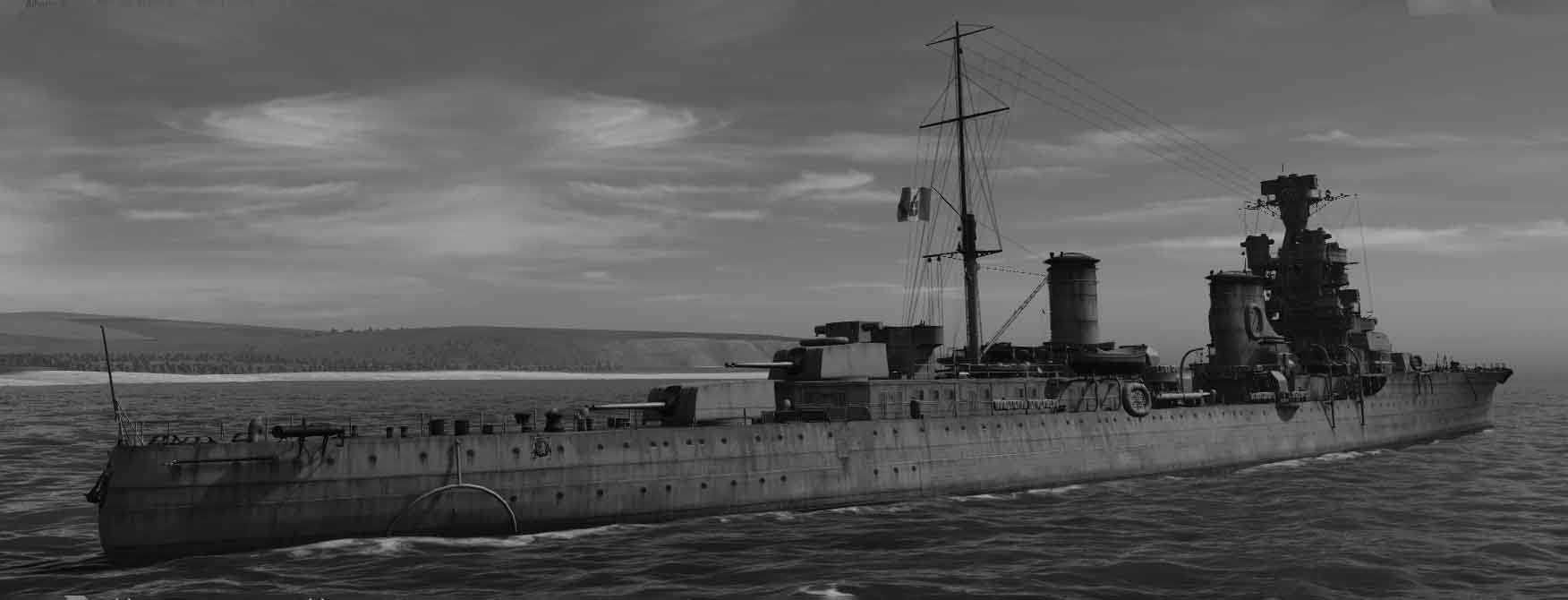
Italian light Cruiser Alberto di Guissano
The ‘early Condotierri’
After the Washington treaty, the threat is very real for the admiralty, which place this threat above all else. Thus, the first Italian cruisers since 1911, are designed from 1925 to deal with these, and only provided by the naval programme of 1927-28. Four of them, the first of a future serie of the so-called “Condotierre”, are ordered in 1928: The Giussano class.
Compared to the earlier Duguay-Trouin class (1923), they carried the same armament over a smaller tonnage (5,000 tonnes standard versus 7,600), typical of a treaty light cruiser: 8x 6 inches (150 mm). For this design, the goal being to hunt down these French large destroyers, it is needed to catch them. So speed is a deciding factor.
The Guissanos are insanely fast for cruisers: 36.5 knots (compared to 33 for the French cruisers). But this is done by reducing armour to the symbolic, and even construction is considered weak. This was made all clear duing WW2. Rather than hunting down French destroyers, two were destroyed by …regular British destroyers. A single torpedo was able to do untold damage, as well as gunnery.
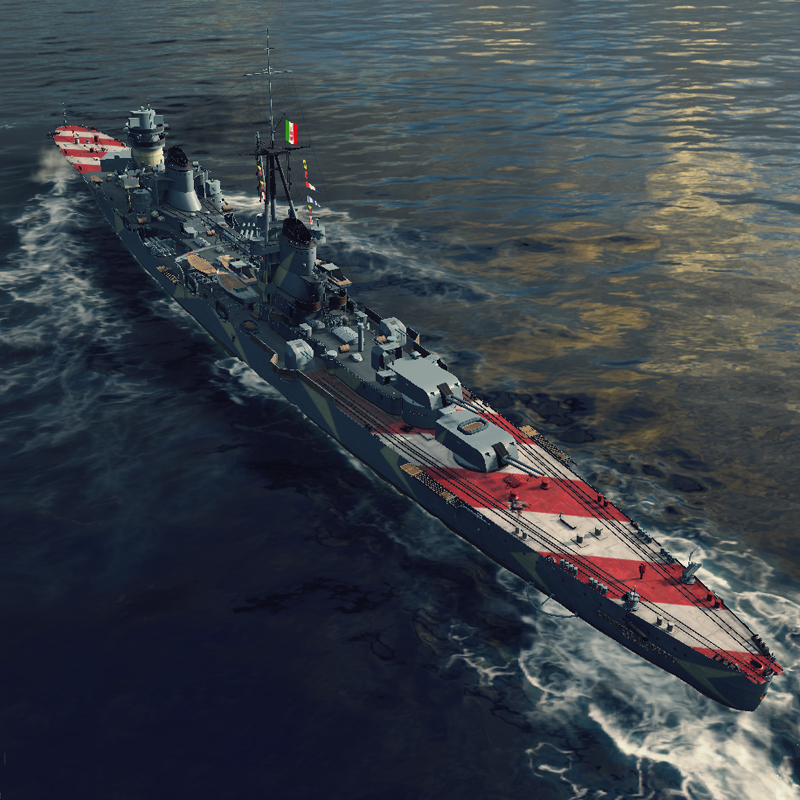
Italian light Cruiser Emanuele Filiberto
What was considered the “second group”, the following four Cadorna class, started two years later in 1930, engineers and the admiralty seems to come back to common sense. Stability issues are solved by reinforcing the hull and lowering superstructures. The goal however is still the same, and the slightly heavier Cadorna are as fast, and with the benefice of a seaplane. In between, when these last two ships are completed in 1933, the French added the Guepard, Aigle, Vauquelin and are completing the 42-knots capable Le Fantasque class, no less than 30 “super-destroyers”, versus six light cruisers. The late Le Fantasque are close to 3,400 tonnes fully loaded, about 2/3 of a Cadorna and armed with 5.5-in/45 guns said quite capable in range and rate of fire, compared to the Italian 152 mm/53 modello 1929. Still, each cruiser could engage two destroyers by staying at a relatively safe margin in ideal conditions.
Back to heavy cruisers
Of course this focus on a destroyer hunter was worrying for the admiralty that also needed cruisers fo regular, traditional cruiser tasks, and they were urgently needed: In 1925 already, the French were laiying down the keel of its first two heavy cruisers, largely based on the plans of the duguay Trouin but scaled up with the typical Washington “eight-eight” configuration (Eight guns, Eight inches) on 10,000 tonnes standard: The Duquesne class. In fact a whole serie of heavy cruisers was planned, one laid down each fiscal year between 1924 and 1930, the second batch being of a slightly revised version (Suffren class).
In answer, the Italians in 1925 already laid down the Trento class. They wluld have been three, but the third (Bolzano) was heavily modified and launched much later, in 1932. They were very comparable to the French ships but emphasis was again on speed and not protection, trying to out-run the French for a possible contest. The Trento reached 36 knots, versus 33, a comfortable margin. This was however paid dearly as both ships showed intense vibration problems and their hull had to be strenghtened (and top speed lowered). Protection was -of course- weak, but comparable to the French, just able to sustain destroyer fire. This was typical of the “tin-clad cruisers” era. In 1930 this began to change, and instead of a repeat of the Trento, the Italians to answer the Suffren class started the Zara:
Instead of targeting a superior speed, the Italian engineers were tasked to produce a more balanced design, with a much better protection. Since speed had many tradeoffs, the Italians would just battered the weakly built Frech cruisers into submissions with much better protected vessels. The admiralty in fact even wanted “armoured cruisers”. This was not only in answer to the earlier Suffren class than to take account of the new -and last- French heavy cruiser, the Algérie, which precisely targeted a much better protection above all else.
Algérie was laid down in March 1931, while the Zara was started two years earlier already in April 1929. In the end, the more futuristic looking Algérie stayed sole in her class -The French having spent their heavy cruiser budget- London treaty obliged. In this match, the Italians had out-smarted the French, with four of these heavy cruisers, versus one, and even arguably better protection in some ways. We can only guess what a duel between a Suffren and a Zara would have been like, but the former stood less chances due to their weaker protection, only counting on a better speed to evade.
Late Light cruisers
Meanwhile, the treaty of London only capped heavy crusers tonnage, not light ones, even now authorized to reach 10,000 tonnes, setup as “ultimate limit for any cruiser”. This made the follow-up in the “Condotierri” serie quite interesting. In that area, the admiralty wanted “conventional” cruisers for traditional missions, and therefore, took the best of the tonnage limits to make strongly built ships with a much better range, where the Guissano/Cadorna were mere “interceptors”.
The Montecuccoli class (3rd group) launched in 1934 displaced about 8,850 tonnes, the same as the French Duguay Trouin, stuck to the 8×6 formula (eight guns, 6 inches), and the Duca d’Aosta class (4th group, 1934) just improved on a few points; With only three light cruisers, the French needed to compensate fast, and they tried to innovate. Instead of sticking to the classic formula of twin turrets, they embarked on triple ones, just like the Germans did with their own earlier K class.
And so the Bertin was built a bit earlier (1934). As a side note, the French also launched 1930 the Pluton and Jeanne d’Arc but both were “special purpose” cruisers, the first a minelayer, the second a schoolship, not really included in this count. Emile Bertin was very comparable to the Italian cruisers, same displacement, almost same dimensions, 34 knots, but the Italians wanted again to be faster and achieved 37. Arguably in arillery the French had the advantage of a ninth gun, versus eight, and in addition all nine were independent, while the Italians had solidary twin mounts. But Bertin was single and the French quickly capitalized on this successful “prototype” to start a serie of six cruisers, La Galissonière, launched 1933-37. By all intent and purposes they answered to the 3rd, 4th and 5th groups, also six ships. All also had nine guns, plus intensive seaplane facilities and a straight stem.
Observing this, the Italians planified to out-gun the French, what they did with a fifth group, using the 10,000 tonnes limit available, with the arguably excellent Abruzzi class. They, too, devised triple turrets but instead of having just three and better concentrate armour, the Abruzzi were even longer and much heavier than their predecessor, to still accomodate four turrets, bringing as a result, a total of ten guns (two twin, two triple), retaking the advantage, although with a less stellar speed and better protection.
Ten guns was good for the Mediterranean, but for the wider world, it was just weak: The British with their Town class -their eyes on the far east- setup a large class of cruisers armed with twelve (four triple) guns, while the Americans, having their eyes set on the Japanese, opposed the fifteen guns armed Brooklyn to the Mogami (Five triple). For the last, sixth group of the Condotierri, the Italians stuck to a ten-gun ship, the Ciano class, but the design was delyed and went through a number of modifications, before being cancelled altogether. They would have faced the French De Grasse class, a repeat of the previous class too, with nine guns. There are more to rals about “wartime” heavy cruisers (see later).
About Exports:
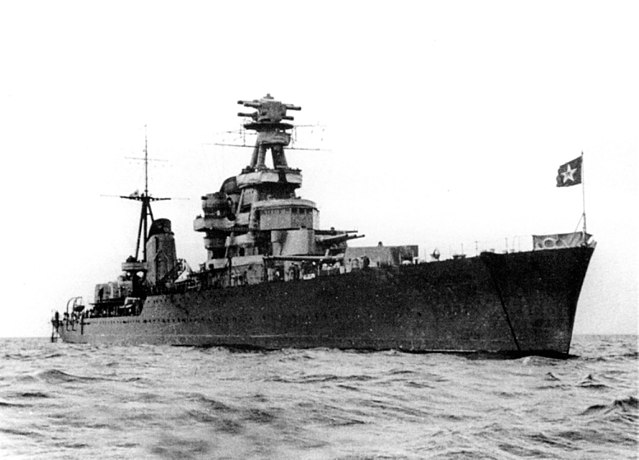
With its sleek lines and quad-mast, the DNA is there (Kirov).
One striking aspect where the Italians easily out-do the French at every corner, was their mastery of exporting their designs and concepts. They sold destroyers for example to Turkey and Sweden, and even cruisers to the Thai Kingdom before the war (Taksin ckass). The French only export successes of the interwar were two submarines to Greece and two destroyers to Poland, plus the refit of the old Yavuz.
Italan designers strongly influenced the Swedes and the Russians, selling or designing cruisers to them and to the Spaniards. The Italians were consulted by the Soviet admiralty when it was time to start producing a new generation of cruisers (the Kirov class) and their mark is definitely there when seeing the style of the class and up to the Chapayev class in 1944. Orlando yard also delivered a prototype of super-destroyer for the black sea, the Tachkent, nicknamed “blue beauty”. This was supposed to be a prototype for a new class to be built in USSR but, the war came before the project was realized.
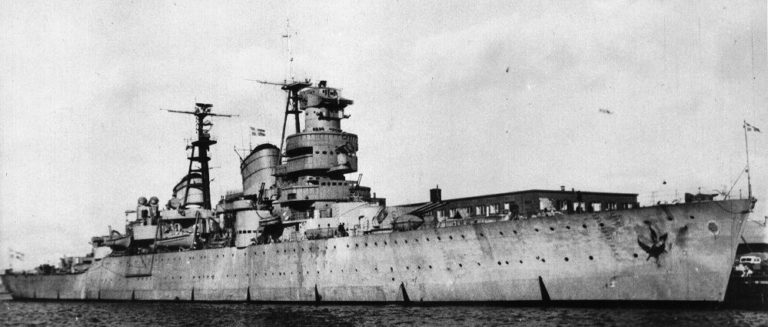
Obviously, design considerations had quite a wight there. Italian designs were aesthetically pleasing, fast and sleek. A reputation which had strong, old historical roots, found in the Renaissance, and which had quite an appeal, still, during the interwar, when streamlining was the norm. Sweden also, in long rivaly with Russia, choose the Italians. Swedish destroyers were strongly influenced by italian design, while the last Swedish cruiser types, the Tre Kronor class, proceeded from an Italian design during WW2, and when completed ad an uncanny “family flair” to late Ansaldo cruiser projects. They are a glimpse into what the hypothetical Spanish cruisers would have look like, if built (see later).
Armament of Italian cruisers
From the highest to lowest caliber. Al links goes to the excellent navweaps.com
- 254mm (10″/45) Model 1908: San Giorgio Class
- 203 mm/50 (8″) Model 1923: Trento class
- 203 mm/53 (8″) Modello 1927/1929: Zara class & Bolzano
- 152 mm/53 (6″) Modello 1926/1929: ‘Condotierri serie’
- 152 mm/55 (6″) Modello 1934/1936: Garibaldi class
- 15 cm/45 (5.9″) SK L/45 war prize German Cruisers
- 135 mm/45 (5.3″) Modello 1937/1938: Capitani Romani class
- 65 mm/54 (2.56″) Model 1939: Capitani Romani and Etna classes (planned)
- 37 mm/54 (1.5″) Modello 1932/1938/1939: Common AA guns
- 20 mm/65 Modello 1935/1939/1940 (Breda): Common AA guns
- 13.2 mm/75.7 (0.52″) AA MG Modello 1931: Main light AA caliber
Onboard aviation of Italian cruisers
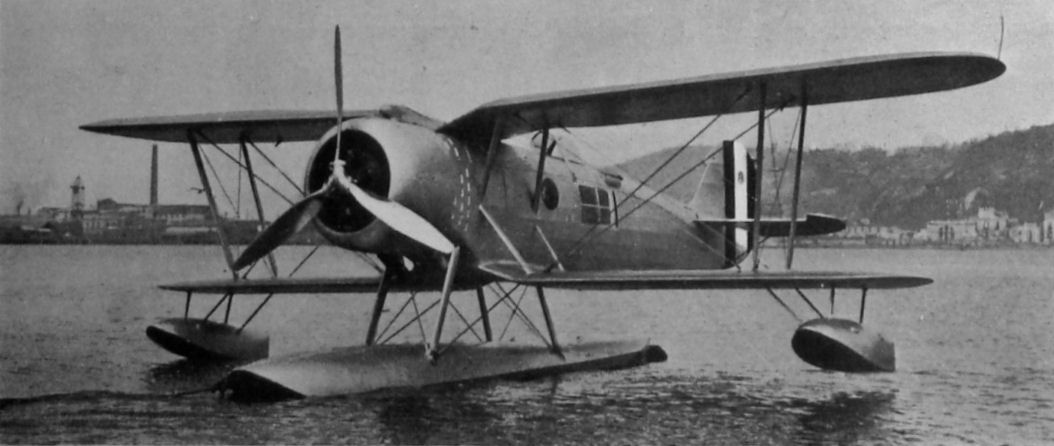
Not all Italian cruisers carried aviation, the largest were concerned: The Trento, Trieste, Bolzano, Cadorna and Diaz, Montecuccoli, Attendolo, Duca D’Aosta, Di Savoia, Abruzzi, Garibali, Ciano (planned). The only large cruisers not fitted with aircraft facilities were the Zara class. The Guissano were not configured for that, and the ‘Capitani Romani’ too small.
The standard model was the Imam Ro-43, a sturdy all-metal gullwing biplane, it will be covered in a specific post as well as the closely derivative IMAM Ro.44 fighter floatplane (1936). The Ro-43 however started to be introduced in 1936, so before that, the Piaggio P.6 catapult-launched floatplane (1927) was likely to be deployed.

Piaggio P.6 (1927): Two-seat catapult-launched seaplane for which Piaggio produced two designs: The P.6bis with a 190 kW (260 hp) Isotta Fraschini V.6 engine driving a pusher propeller. The P.6 had one large central float and two stabilising floats at the wingtips. It was given a nose-mounted A.20 engine. In 1928, the P.6ter was produced based on the P.6 floatplane with the engine boosted to 306 kW (410 hp). 15 P-6ter aircraft were manufactured by the Italian Navy and became widespread on battleships and cruisers.
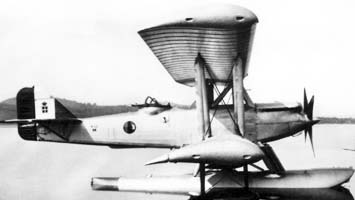
Macchi M.40 (1928): Single prototype tested. Credits airwar.ru
Captured Cruisers
These were ex-French cruisers, available after Jean de Vienne and La Galissonière, scuttled at Toulon in November 1942, were taken over by the Italian Navy. They were refloated in the following year and redesignated FRII and FRI2 respectively. Plans were drawn up to repair and refit them for Italian service, and work has begun, but very slow progress was made, until both were sunk in Allied air raids. For details of these ships see under France.
WW1 cruisers in interwar and ww2 service
 Bari (1920)
Bari (1920)

Pillau only briefly served in the Reichsmarine, was stricken on 5 November 1919 and was seized by the allies in Cherbourg on 20 July 1920, lated ceded to Italy under the provisionnal name “U”. She was renamed “Bari” recommissioned on 21 January 1924 as scout cruiser. Its 8.8 cm AA guns were replaced by Italian 76 mm (3 in)/40. In August 1925, she ran aground off Palermo (Sicily), refloated on 20 September. She served with Ancona, Taranto and Premuda as the Scout Division of the 1st Squadron at La Spezia.
Modifications: Modified bridge, forward funnel shortened. In 1933–1934, she was refitted for colonial service, converted to oil-firing, with additional oil bunker space, forward funnel removed, the others lowered. She was down to 21,000 shp for 24.5 kn (45.4 km/h; 28.2 mph) but her range went from 2,600 nmi to 4,000 nmi (7,400 km; 4,600 mi) at 14 kts. Bari was sent in the Red Sea, Italian East African fleet, in station until May 1938, relieved by the sloop Eritrea and in September 1939, she received six 20 mm (0.79 in) and six 13.2 mm (0.52 in) AA. In 1940 she was the flagship of the Forza Navale Speciale during the Greek invasion, supporting the attack on Cephalonia and shelled Greek positions in mainland Greece. From April 1941 she escorted convoys to Greece. In 1942, Bari and Taranto were mobilized for the invasion of Malta, to lead the landing force but it was cancelled. In November 1942 she became flagship of the amphibious landing in Corsica and took part in anti-partisan bombardments off the Montenegrin coast. She ended in Livorno, placed in reserve in January 1943.
She was later slated for conversion to an AA cruiser, but the planned rearmament with six 90 mm (3.5 in)/50 guns, eight 37 mm (1.5 in), eight 20 mm/70 scheduled to start on 28 June, was distrupted after an allied bombing which damaged Bari, and she sank in shallow water two days later. The German occupiers parachieved the destruction to retreive scrap metal in 1944. She was raised after the war for BU.

Sunk in Livorno, 1943. Note the hull has been camouflaged.
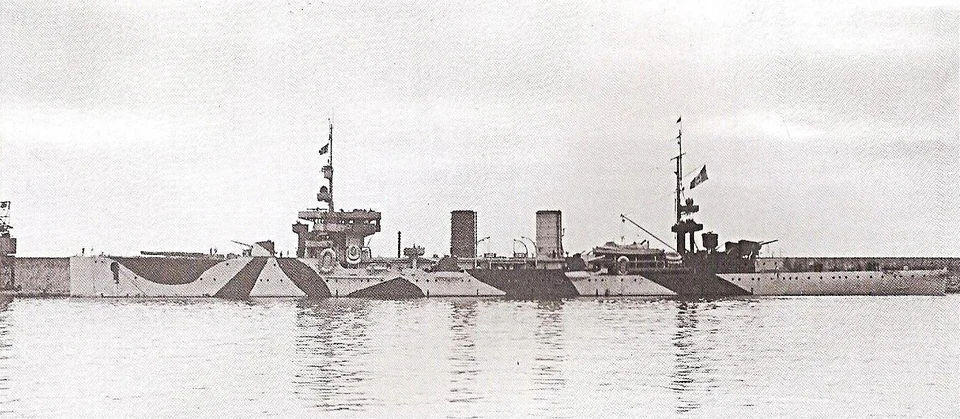
Bari in 1942, carmouflaged (from reddit, shipporn)
Specifications (as rebuilt)
Propulsion: 2 shafts Parsons turbines, 4 oil-fired boilers, 21,000 shp.
Top speed: 24.5 knots
Armament: 10 x 152 (2×2, 2×3), 8 x 76mm (8×1), 8 x 37 AA, 8 x 13.2 AA, 6 x 533 mm TTs (2×3)
 Venezia class cruisers (1920)
Venezia class cruisers (1920)
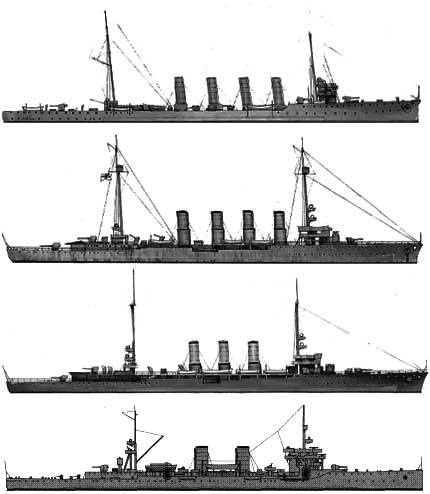
Both Venezia and Brindisi were former Admiral Spaun class cruisers, given a war prize. Italy received Helgoland on 19 September 1920 (Saint-Germain-en-Laye treaty), she was renamed Brindisi and anchored at Bizerte, Tunisia, rated as esploratore (scout cruiser) and headed for la Spezia on 26 October, for the Scouting Group (Gruppo Esploratori). She was modified from 6 April to 16 June 1921 (notably Italian guns, modified bridge) and became flagship of Rear Admiral Massimiliano Lovatelli, commander of the Light Squadron. She operated off Istanbul and visited several ports in Italy, Greece, and Turkey. She relieved San Giorgio as flagship of the Eastern Squadron and departed on 6 October for the Eastern Squadron, back to Italy on 7 January 1924.
Brindisi hosted King Victor Emmanuel III during the Fiume transfer ceremony (Treaty of Rome), then was transferred to Libya. Back to Italy she was transferred to the Scout Squadron in 1926 and soon paced in reserve, reactivated in 1927, assigned flagship of the 1st Destroyer Squadron (Rear Admiral Enrico Cuturi). She then joined the Special Squadron (Rear Admiral Antonio Foschini) on 6 June 1928. In 1929, she cruised the Eastern Mediterranean and she was disarmed on 26 November, used as a depot ship at Ancona, Pula, and Trieste, stricken in 1937.
Saida was also ceded to Italy, commissioned as Venezia on 5 July 1921. Like he sister, her 6.6 cm AA guns were replaced by 37 mm (1.5 in); and she served from 1930 as a barracks ship at Genoa and La Spezia. In September 1935, she was drydocked at La Spezia and prepared to be scrapped, which was only done after she was sold on 11 March 1937. Note: Photos of both cruisers are excessively rare. If you know some, please contact me !
 Ancona (1920)
Ancona (1920)
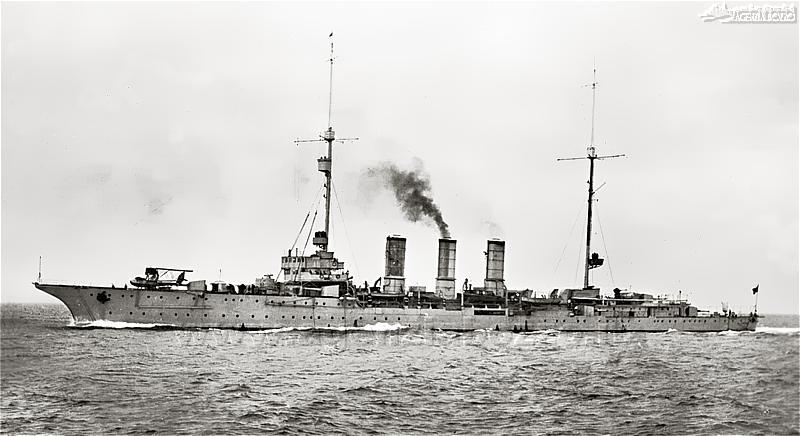
Ancona in 1930, showing her new bow and catapult
Graudenz only served briefly with the Reichsmarine in 1919 but she was stricken in March 1920, surrendered to the Allies as war prize, awarded to Italy on 1 June 1920 (“E”) in Cherbourg. She was renamed Ancona, and overhauled at arrival between 1921 and 1924. This extensive reconstruction saw her partially re-boilered (six oil-fired models) the remaining six modified as mixed (oil-coal). Coal storage space was reduced from 1,280 down to 900 metric tons while oil bunkerage went from 375 t to 1,520 t. She saw her superfiring 15 cm gun moved amidships but was moved back later to make room for a new platform holding a scout plane. She carried a Macchi M.7, then CANT 25AR.
Ancona was fully recommissioned on 6 May 1925 but soon was refitted again in 1928–1929. A fixed aircraft catapult was installed in the bow whih was lenghtened, into a specific clipper bow. She also tested the utility of a bow fixed catapult. The arrangement was used in the Trento and Zara classes notably. Ancona joined Bari and Taranto and Premuda to form the Scout Division, 1st Squadron (esploratori) in La Spezia from 1929. Ancona was in average condition, and was laid up in Taranto after her only cruise in August 1932. She served as spare parts reserve for Bari and Taranto, for that the admiraly had trouble to maintain properly.
There were proposals at that time to rebuilt Ancona more thoroughly as a colonial cruiser in 1936 (new oil-fired boilers ducted into a single large funnel, more range, three 76 mm (3.0 in)/40 AA guns. But it was dropped due to cost issues. In April it was proposed to just arm her as a floating AA battery. Both her boilers and aft superstructure were to have been removed, providing space for twenty-six 100 mm (3.9 in) 47-cal. guns, all twin mounts, plus installation of a dedicated fire-control director. The cost seemed excessive and the project dropped again. Third option, futting a new propulsion system for her to be used as escort vessel. But she was evetually stricken on 11 March 1937 and sold.
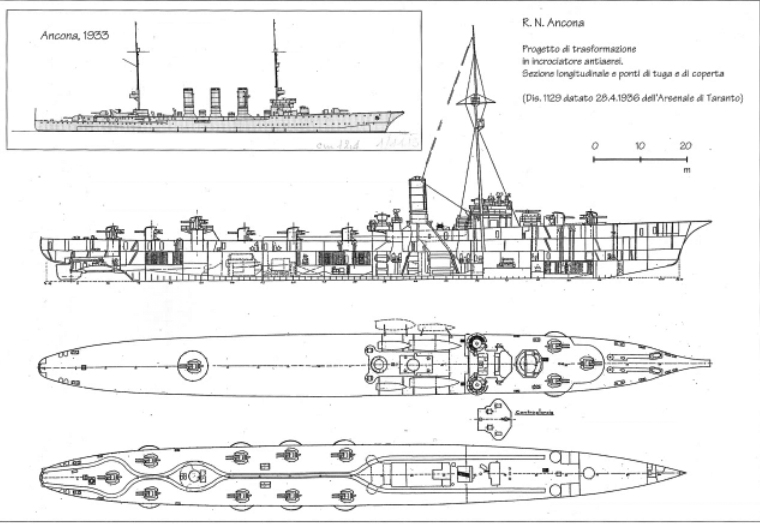
Ancona 1935 AA conversion project
 Taranto (1920)
Taranto (1920)
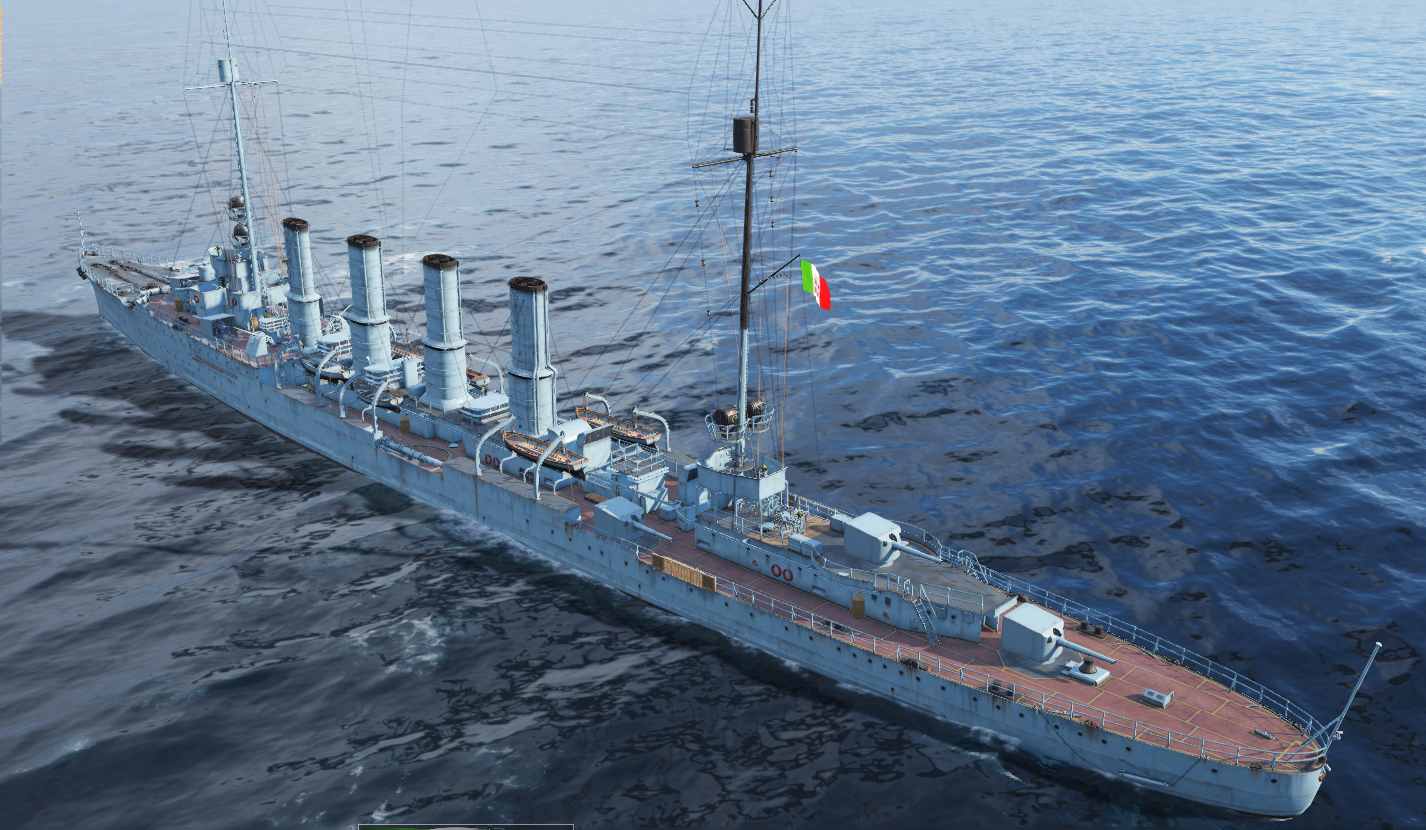
Cruiser Tarento, former SMS Strassburg. The Tarento was the former German cruiser KMS Strassburg granted in 1920 as a war damage to the Italian government, along with Venezia and Brindisi (former Austro-Hungarian class Saida), and Ancona (formerly Graudenz), and Bari (ex.Pillau). The Tarento was completely rebuilt in 1936-37, the front funnel was truncated in the second and at when war started, AA artillery was added, in four twin mounts, 20 mm Breda cannons.
Tarento served as a colonial cruiser, but guarded the territorial waters during the war. She was scuttled at La Spezia to avoid capture during the 1943 surrender by the Germans. They managed to get the ship back, but the repairs were underway when an allied raid sank the ship in October. She was refloated and sank again during another air raid, and this time it was left as is. The hull will be refloated after the war.

What-if camouflaged Tarento in 1942 – Author’s illustration.
Note: A dedicated post will be made on the future, with profile reconstitutions and far more data and photos.
 San Giorgio class cruisers (1908)
San Giorgio class cruisers (1908)
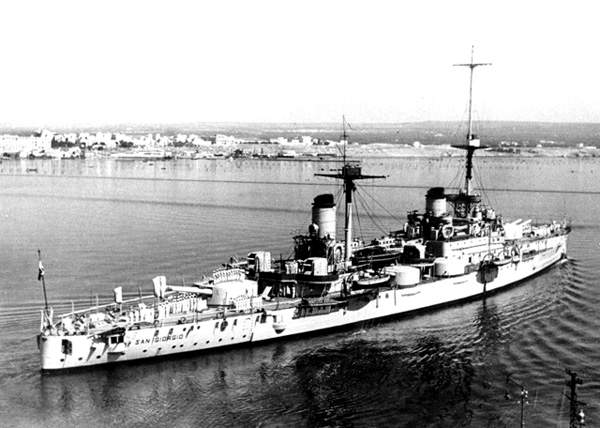
San Giorgio at Tobruk, 1940
The San Giorgio and the San Marco were two battlecruisers of 1908, which made the pride of the Italian Navy. Already in 1918, they were overwhelmed, but the Admiralty decided to keep one in use, the San Giorgio, to convert it into a coastal defense vessel, preferably assigned to the colonies of North Africa. While his twin was disarmed and converted into a target ship, the San Giorgio was brought to the arsenal of La Spezia in 1937 for major redesign work, which largely changed its appearance.
Her powerplant was modified, as she received 4 oil boilers instead of the original 8 coal-firing ones, reduced masts, remodeled superstructures, and the AA artillery was considerably beefeded up, with eight 100 mm guns, and seven twin 13.2 mm heavy machine guns. They kept part of their armor and heavy guns, still very effective despite their limited range and rate of fire. In 1940, San Giorgio received an additional 100mm twin turret and 6 twin AA 20 mm Breda AA gns to be used in Tobruk as AA defense battery ship. She was scuttled there at the announcement of the impending capture of the city by British troops, on January 22, 1941.

Author’s Illustration of San Giorgio in 1942
Specifications
Displacement: 9,470 t. standard -11 500 t. Full Load
Dimensions: 145 m long, 18.90 m wide, 6.30 m draft
Propulsion: 2 propellers, 4 Yarrow boilers, 60,000 hp.
Top speed: 14 knots
Armour: Belt 250, bridge 30-60, turrets 250, blockhouse 300 mm
Armament: 4 x 254 (2×2), 8 x 152 (4×2), 8 x 100 (4 × 2), 14 x 13.2 AA, 2 x 533 mm sub TTs
Crew: 650
Read More/Src
Conway’s all the worlds fighting ships 1906-21 & 1922-46
Nomenclature of ww2 italian cruisers
Trento class class heavy cruisers (1924)
In 1920, Italy emerged from conflict with old ships of low military value. The Washington Treaty had set standards for heavy cruisers, and the arrangement of eight 8-in (203mm) in four twin turrets for less than 10,000 tons was followed by all signatory nations, including France, which studied them in 1922-23. The Italians defined the Trento in the 1924 program as ships for which speed was paramount, as were battle cruisers, due to their traditional role of fleets scouts and commerce raiders.
They had to escape battleships while posing a threat to light cruisers and destroyers. As a result, the Trentos had only 4-in plating as maximal protection, and standard internal shielding forming a “box” extending from the second to the third main turret. Turrets faces and conning tower only were given 100 mm armor thickness.
This light construction resulted in excessive vibrations at full speed from the tripod masts, shaking the firing direction station. This grave defect that was eliminated by the reinforcement of these masts (5-pods) and the installation of additional framing making the top speed speed falling to 31-32 knots. They carried two seaplanes, launched from the catapult of forward deck in front of the turrets, and housed in the hangar located just in front of the first turret.
Their main anti-aircraft artillery counted dual-purpose 100 mm shielded twin mounts, which had a relative effectiveness because of their WW1-vintage Austrian origin, readapted to specific marine DP, but of weak range, muzzle velocity and rate of fire. They were replaced by the new models in 1933. The AA passed from a few 40 mm and 12.7 mm HMGs during the rearmament of 1937, to new twin 37 mm mounts instead and in addition to extra Breda HMGs.
Their active career was full, the two ships participating in the Battle of Cape Matapan, the Trento participating in the action of Calabria in July 1940, then in the second battle of the Great Sirte in March 1942 and was sunk by HMS Umbra during operations against convoys to Malta, 15 June 1942. Trieste, torpedoed in November 1942 while escorting a convoy by HMS Utmost, managed to return to Messina with several thousand tons of water in her hull. She was sunk by RAF aircrafts in the harbor of Maddalena, Sardinia, on April 10, 1943.

Proposal to convert the Bolzano into an aircraft carrier.
Specifications
Displacement: 10,340 t. standard -13,330 t. Full Load
Dimensions: 197 m long, 20.60 m wide, 6.80 m draft
Propulsion: 4 shaft Parsons turbines, 12 Yarrow boilers, 150,000 hp.
Top speed: 36 knots
Armor: Belt 70, decks 50, turrets 100, blockhouse 100 mm
Armament: 8 x 203 (4×2), 16 x 100 (8×2), 4 x 40 AA, 8 x 13.2 AA, 8 x 533 mm TTs (4×2)
Crew: 780
 Giussano class light cruisers (1927)
Giussano class light cruisers (1927)

The four cruisers of the Giussano class are the first in the Condottieri series. These are Albercio da Barbiano, Amberto di Guissano, Bartolomeo Colleoni and Giovanni delle Bande Nere. They were originally designed to respond effectively to heavy French destroyers of the Eagle, Jaguar and Lion classes. In order to do this, they sacrificed everything at the speed.
Indeed with 38 to 39 knots in practice, and even 42 for Barbiano, they were among the fastest cruisers in the world. However, their protection was almost non-existent, and their stability was mediocre, which made them bad shooting platforms. The range of their parts was to ensure their protection at a distance of 5 bursts per minute.
They were also uncomfortable, poorly arranged and suffered from poor autonomy. In operations, these defects reappeared, and none survived. The Bande Nere was sunk by the submarine HMS Urge near Stromboli, the Colleoni in July 1940 by the cruiser Sydney, the Barbiano and Giussano by destroyers HMS Legion, Maori, Sikh and Dutchman Isaac Swers during the battle of the cape Good December 13, 1941.
Specifications
Displacement: 5,110 t. standard -6,840 t. Full Load
Dimensions: 169.30 m long, 15.30 m wide, 5.30 m draft
Propulsion: 2 propellers, 2 Belluzzo turbines, 8 Yarrow boilers, 95,000 hp.
Top speed: 36.5 knots
Armor: 42, Deck 20, Turrets 23, Blockhouse 40-25 mm
Armament: 8 x 152mm (4×2), 6 x 100mm (3×2), 8 x 37mm AA, 8 x 13.2mm AA, 4 x 533 TTs mm (2×2)
Crew: 520
 Cadorna class light cruisers (1930)
Cadorna class light cruisers (1930)

Cardona
The second Condottieri group was to have in 1930 two units very close to the previous Giussano. They corrected one of the essential shortcomings, stability, on the one hand by adopting side “bulges”, but also by lowered superstructures and better distributed weaponry. These efforts were accompanied by a slight increase in weight, their dimensions remaining unchanged, and they had new, more spacious turrets for their servants. Following the very fast but fragile Giussano, the two Cadornas are coming to their senses.
Equipped to lay mines, they could carry 138 of the smallest model. The Cadorna managed to reach 39.7 knots during testing. it was rearmed in 1944, receiving 4 double 20 mm AA carriages and losing its catapult and torpedo tubes. It survived the war and remained in service until 1951. Its twin Armando Diaz received a torpedo volley from the submarine HMS Upright and sank while escorting a convoy to Tripoli in February 1941.
Specifications
Displacement: 5,230 t. standard -7,000 t. Full Load
Dimensions: 169.30 m long, 15.50 m wide, 5.50 m draft
Propulsion: propeller machines, 2 Parsons turbines, 6 Yarrow boilers, 95,000 hp.
Top speed: 36.5 knots
Armour: Belt 40, bridge 20, turrets 23, blockhouse 40 mm
Armament: 8 x 152 (4×2), 6 x 100 (8×2), 2 x 40 AA, 8 x 13.2 AA, 4 x 533 mm TTs (2×2)
Crew: 544
 Heavy cruiser Bolzano (1932)
Heavy cruiser Bolzano (1932)

Author’s profile of Bolzano
The heavy cruiser Bolzano was both from the previous Trento and Trieste, but revised and corrected following the construction of the four Zara. The latter had better protection at the cost of their speed. With the Bolzano, we had tried to remedy it. It was put on hold in 1930 and completed in 1932, commissioned the following year. Of dimensions and tonnages neighbor of the Trieste, its hull was however with detachment (forecastle) and not more flush-deck, and its superstructure of completely different footbridge.
Instead of a simple tower anchored to the front tripod mast, it encompassed the tripod mast and front chimney and was larger. The Bolzano had eight 203 mm pieces in four classic double turrets, complemented by eight double 100 mm, four 40 mm single, and eight 13 mm Breda machine guns, in addition to the two fixed flanks of lance tubes. -torpilles. The power unit had been split into two units to provide a central hangar for three seaplanes, served by a catapult between the two funnels.
In 1938-39 this armament was revised. One of the 100 mm double turrets was landed for four more 20 mm and later four additional 20 mm carriages in 1942. During the Battle of Calabria he was hit by three shells. Later in 1941, it was torpedoed by the HMS Triumph, then in 1942 by HMS Unbroken and remained in repairs until the Italian capitulation in La Spezia. It was the Italians themselves who sent it to the bottom with the MAS75 to avoid its capture by the Germans. It will be refloated and demolished after the war.
Specifications
Displacement: 10 886 – 13 865 FL
Dimensions: 197 x 20.60 x 6.80m.
Propulsion: 2 Parsons turbines with reducers and 10 Yarrow boilers, 2 propellers, 150,000 hp and 36 knots
Armor: Decks 50 mm, belt 70 mm, turrets 100 mm, CT 100 mm
Crew: 780
Armor: 8×203 (4×2), 16×100 (8×2), 4×40, 8×13 AA, 2×4 TTs 533mm.
 Zara class Cruisers 1933
Zara class Cruisers 1933

Author’s profile of the Zara class
The four Zara class ships remain the most famous Italian cruisers of the Second World War for having the sad privilege, with the three American cruisers of the New Orleans class a little later, to have been cast at close range without having fired a single shot, and this during the famous battle of Cape Matapan, probably the first and last big classic engagement of Regia Marina. The Zara (launched in 1930), the Fiume (1930), the Gorizia (1930), the Pola (1931), were an evolution of the heavy cruiser after the two Trento.
Design
It was a question moving the cursor from speed to protection, in particular by the adoption of smaller dimensions (183 against 196 meters long, but a width unchanged to preserve stability, as well as refitted superstructures, and in general vital parts concentrated in a short space for a better repartition of the armor). Thus their full speed displacement increased from 13,300 to 14,300 tons). Also protection reached in many places 150 mm against 100 to 70 at best on both Trento.
Their firepower remained unchanged except for the range of 203 mm pieces, their best DCA and the abandonment of the torpedo tubes. Developing 95,000 hp instead of 150,000, because of the reduction in the number of boilers (8 against 12), their maximum speed in operation did not exceed 32 knots. However at the tests, the Pola maintained 34.2 knots with all the available power. the Pola had a bridge structure different from the other three since it extended to the rear, encompassing the funnel a concept that was taken over the Bolzano.
The Zara class in action
All four were therefore sunk by war, Zara, Pola and Fiume during the fatal night of March 29, 1941 off Cape Matapan, and the Gorizia in June 1944 by chariots handled by Free Italian crews. South in the harbor of La Spezia.
Specifications
Displacement 11,680 tons standard -14,300 tons Fully Loaded
Dimensions: 182,80 m long, 20,62 m large, 7,20 m draft
Machinery: 2 shaft Parsons turbines, 8 Thornycroft boilers, 95,000 hp.
Top speed: 32 knots
Protection: Belt 150, decks 70, turrets 150-120, CT 150 mm
Armament: 8×203 (4×2), 6×100 (8×2), 6×40 AA, 8×13.2 AA
Crew: 880
 Montecuccoli & Duca d’Aosta class cruisers (1934)
Montecuccoli & Duca d’Aosta class cruisers (1934)

Author’s profile of the D’Aosta class
The four cruisers of groups III and IV of the superclass Condottieri, included Raimondo Montecuccoli (launched in 1934), Muzio Attendolo (1934), for the first and Emanuele Filiberto Duca d’Aosta (1934), Eugenio di Savoia (1935) for the second. These four buildings, very similar in design and appearance, only differed in size and displacement. They were a real advance over the previous “Cadorna”, from a “destroyer killer” role to that of “cruisers” truly.
The major concern was to increase protection. Therefore we opted for a full and thicker armor, which was also reflected in the layout plan larger volume. Much more habitable (12 meters longer, 1.10 in width and 50 cm of additional draft), and better protected, (between 100 and 60 mm in places against 40 mm at most on Cadorna), these units sacrificed finally little speed: With 106,000 hp against 95,000 on the previous class, and despite a displacement of 8850 tons against 7000 at full load, they managed to support 37 knots at full speed.
The armament did not change, except in the adoption of a DCA at the height (4 double carriages of 37 mm against 2 singles of 40 mm on the Cadorna). The buildings of the Duca d’Aosta class took up most of it, if not further improved protection, and had larger dimensions, of the order of 187 meters long by 17.50 meters in width, a much larger displacement, rising to 10 600 tons at full load, compared with the 6800 tons of Group I in 1930. Their speed fell slightly with a power of 110,000 hp, at 36.5 knots. Of these four buildings, only one was lost in combat, the Muzio Attendolo during the RAF bombing of Naples on 4 December 1942. Montecuccoli served as a cadet training ship until 1964, and both of Group IV were awarded to the USSR and Greece in war damage. Under the name of Kerch the first served until 1958-59 as auxiliary cruiser, the second under the name of Helle until 1964.
Specifications
Displacement: 7,405 t. standard -8 850 t. Full Load
Dimensions: 182.20 m long, 16.60 m wide, 6 m draft
Propulsion: 2 propellers, 2 Belluzzo turbines, 6 Yarrow boilers, 106,000 hp.
Top speed: 37 knots
Armor: Belt 85, bridge 30, turrets 70, blockhouse 100 mm
Armament: 8 guns 152 (4 × 2), 6 guns 100 (3 × 2), 8 of 37 AA (4 × 2), 8 of 13.2 AA, 4 TLT 533 mm (2 × 2)
Crew: 650
 Abruzzi class cruisers (1937)
Abruzzi class cruisers (1937)

Author’s profile of the Abruzzi class
This class also counting the Guiseppe Garibaldi was built by OTO shipyards in La Spezia, the lead ship being named after Luigi Amedeo, Duke of Abruzzo, Italian explorer and admiral of the First World War. The Duca degli Abruzzi class cruisers were the final version of the long-standing Condottieri class and were bigger and better protected than their predecessors. The armament was increased by two additional 152 mm guns in triple turrets at positions A and Y.
The engine unit was also fully revised, allowing greater reliability but with a slightly lower maximum speed than their predecessors. The first of the two cruisers was completed in 1937, forming the 8th Cruiser Division 8 with Giuseppe Garibaldi. Duca Degli Abruzzi, known for his famous zebra camouflage applied in 1942 participated in the Battle of Calabria, leading the squadron of light cruisers that fired the first salvoes of the battle in September 1940. Part of the fleet tried to intercept the British convoys which led to the Battle of Cape Matapan September 24, 1941.
The Degli Abruzzi was damaged by an aviation torpedo on 22 November 1941, was repaired, but interned by the Allies after the Italian Armistice. He later served in the South Atlantic against operations against potential German privateers. After the war its torpedo tubes were replaced by two 4-inch anti-aircraft guns.
In 1953, the ship was upgraded, equipped with a radar AN / SPS-6 2D aerial watch. Following negotiations leading to the handover of Trieste to Italy, the cruiser was transferred from Taranto to Venice, in order to strengthen Italy’s position at the negotiating table. On October 26, 1954, the Duca degli Abruzzi was the flagship of the Italian naval force taking possession of the port facilities of Trieste. He served still in the Marina Militare until 1961.
Specifications
Displacement: 9,440 – 11,575 tonnes FL
Dimensions: 187 x 18.90 x 6.80m.
Propulsion: 2 shafts with reducers, 8 Yarrow boilers, 100,000 hp, 34 knots
Armor: crew: Bridges 40 mm, belt 130 mm, turrets 135 mm, blockhouse 100 mm, Crew 692
Armament: 10×152 (2×3, 2×2), 8×100 (4×2), 8×13 AA, 8 (2×4) 533 mm TTs.
 “Capitani Romani” class light cruisers (1941)
“Capitani Romani” class light cruisers (1941)

In this class a return was made to the concept of ‘destroyer of destroyers’, The ships were intended primarily to counter the large French destroyers of the Fantasque and Mogador classes and, as those ships had design speeds Machinery: of 39-40kts, the exceptionally high speed of 41kts was specified for the new design. To allow for the construction of a reasonable number, and keep costs down, design displacement was limited to 3400t with only splinter protection to the machinery, guns and control positions. In effect the resulting vessels were little more than very large, fast destroyers, although they had a distinctive cruiser profile with a flush deck and two funnels. Detailed design resulted in a slight increase in displacement and abandonment of the machinery protection, splinter plating being provided for the bridge (15mm) and gun turrets (20mm) only.
The machinery was arranged in two separate groups each consisting of 2 boilers and 1 turbine, one group forward and one aft separated by a small auxiliary machinery room amidships. All boilers were in individual compartments.
No trials appear to have been run, as those units completed did so after the outbreak of war, but they are reported to have reached 41kts in service with Augusto and Germanico, was reach out without difficulty. Sea speed was 36kts, an excellent figure which would have allowed sufficient margin for both running down destroyers and escaping from cruisers. The 135mm guns were fitted in twin turrets providing Displacement: 3686t standard, Dimensions:
455ft pp. (138.76 m), 142 feet wide, 2-shaft Belluzo, Armament: 8-135mm, Complement: 418 (as designed).
The 135mm guns were fitted in twin turrets providing 45 elevation, giving a range of 21,400yds, and a rate of fire of 6 rounds per minute. They also carried a new type of quadruple TT (with the tubes in two vertical pairs instead of the more usual side-by-side arrangement) and 24 DCs. and were equipped for minelaying (114-130 mines depending on type). Of the three units completed, Africano carried a short pole mast on her after director, Regolo a pole mast abaft her secund funnel and Magno no mast. All three were fitted with a tripod foremast to support the aerial of an EC3 radar set but only Regolo and Africano were actually fitted with the equipment. Work on Druso, Tiberio, Agrippa and Emilio ceased in June 1940, Truiano was sunk by “Chariots” Tranterred to Palermo.
Mario was completed as a hulk for use as a fuel depot in January 1943 and, with the incomplete Silla, Augusto and Germanico, was seized by the Germans afher the surrender. Silla and Augusto were sunk in Allied air raids, at Genoa and Ancona respectively. Mano und Germanico were suttled by the Germans, the former at La Spezia and the later, 28.9.43, at Castellammare. In 1947, Germanico was salvaged and, together with Magno, was completely refitted and modernised 1951-55. They were renamed San Marco and San Gorgio respectively, being classified as scouts initially and then destroyer leaders. Regolo and Africano were transferred to France in 1948 under the terms of the peace treaty and renamed Chateaurenault and Guichen respectively. They were discarded in 1962 and 1961 and became training hulks.
Extra Note:
French heavy destroyers posed a threat to the Regia Marina. The last ones, those of the Mogador and Fantasque class, must have had an appropriate response. This is the “super destroyer” project, a concept that emerged from what the Royal Navy called flotilla leaders, and which it began to build in 1916-17. During the thirties, the concept was reinterpreted, and shortly before the war, these ships had in common exceptional dimensions, an armament composed of four double turrets and more, and guns of 130 to 140 mm. All the navies built them, the Soviets had the Kiev and Tashkent, the British built the Dido, the Americans the Atlanta, the Japanese the Akitsuki.
The speed was, as for the first “Condottieri”, an important motivation, and the new specifications included the possibility of exceeding 41 knots. With limited movement and poor engine room protection, these buildings needed to be able to catch destroyers and evade cruisers. They were armed with the new 135mm Modello 1939 guns common with the Medaglie d’Oro class of destroyers. for the rest, their configuration was that of large destroyers, with two quadruple axial torpedo banks and a powerful AA armament. But under construction in 1939, the 12 units fell victim to the start of the war and only 8 units were launched and 3 completed, the Attilio Regolo in May 1942, the Scipione Africano in April 1943 and the Pompeo Magno in June 1943. The Giulio Germanico was after the war and with the Pompeo Magno, completely modernized and renamed, remained in service until 1964 and 1971. The other two went to France in 1948.
Specifications
Displacement: 3,680 t. standard -5,334 t. Full load
Dimensions: 142.90 m long, 14.40 m wide, 4.90 m draft
Propulsion: 2 shaft 2 Belluzzo turbines, 4 Thornycroft boilers, 110,000 hp, 40 kts
Armor: None
Armament: 4×2 135mm, 8 x 37mm AA, 4×2 20mm AA, 2×4 533mm TTs.
Crew: 420
Italian cruisers projects
 Costanzio Ciano class (1939)
Costanzio Ciano class (1939)

Src: stefsap.wordpress.com, modified by me.
Slightly improved versions of the Abruzzi class, ordered under the COSTANZO CIANO class (“Condottieri type – sixth 1939 40 Programme but suspended in June 1940 and never begun owing displacement: 9615t standard; 11,810t full load to the need to concentrate available resources on smaller warships. They Would have been of similar appearance to the previous class but with a bridge structure modelled on that of the Littorio class and the modernised battleships.
Other variations included the provision of thicker deck protection, higher power machinery to compensate for increased size, a modified AA battery to include new 90mm and 20mm mountings, and a proposal to carry 4 instead of 2 aircraft. The proposed name for the second vessel was altered in 1940. These were the COSTANZO CIANO and VENEZIA (ex-Luigi Riamo). Armament comprised ten 152mm/55 Modello 36 in two triple and two upper twin turrets, like for the Garibaldi class, and eight twin 90mm 50 AA DP, plus two triple deck 533mm TTs, and two Depht Charge throwers. 3D View – Read More
Costanzio Ciano class Specifications
Displacement: 9615 tonnes standard, 11,810 tonnes FL
Dimensions: 620ft oa x 62ft 4in x 22t 7in mean at full load (189.00 x 19.00 x 6.90m)
Propulsion: 2-shaft geared turbines, 8 boilers, 115,000hp 35ks
Armor: Belt 100mm, deck 45mm, turrets 14imm. CT 40mm
Armament: 10x152mm/55 Mod 36 (2×3, 2x 2), 8x90mm 50 AA (6×2), 6x533mm TT (2×3), 2 DC throwers
Crew:
 Progetto 986 CL (1940)
Progetto 986 CL (1940)
To be named “Giovanni Vitelleschi”, this was extracted from National maritime archives. A 15,500 tonnes wartime light cruiser design, 213.9 m long for 22 m in beam.
She was to be armed with four triple 152 mm guns (same model as Ciano or /60 caliber), two quadruple 21-inches (533 mm) torpedo tubes banks, six twin 90 mm duel purpose guns, eight twin 37 mm Breda AA guns, four twin 20 mm Breda AA guns. Her armour would have been around 150 mm for the main barbettes,
Barb 150
Estimated Specifications
Displacement:
Dimensions: 620ft oa x 62ft 4in x 22t 7in mean at full load (213.90 x 22.00 x 7m)
Propulsion: 2-shaft geared turbines, 8 boilers, 200,000hp 35ks
Armor: Belt 120mm, deck 50mm, turrets 150mm. CT 50mm
Armament: 12x152mm/55 Mod 36*(4×3), 8x90mm 50 AA (6×2), 8x533mm TT (2×4), 8×2 37mm, 2×2? 20mm AA
 Spanish Proposal (1940)
Spanish Proposal (1940)




Also known as Project XII to the Spanish, this 1937 proposal by Ansaldo was ordered by Spain. There were three variants of what is called now by historians, Italy’s “super washington” cruisers. They are a reminder of what Itakly could have produced in wartime with the right industrial capabilities, time and budget, freed from the Washington treaty and London treaty limits. Two of the the proposals were equipped with eight-in guns (203 mm) either with simple four twin or three triple main turrets, but the most extreme had no less than four triple 152mm main gun in a configuration recaling the IJN Mogami.
As late designs all three benefits from the panel of modern AA the Italian industry had to offer tat that time, 90mm, 37mm and 20mm AA guns. The Spanish proposal was also much heavier and larger than previous designs or the Ciano class, because they were considered as “armoured cruisers”, wielding a better armor, and also a better torpedo armament with quadruple tubes, uncommon for Italian cruisers. The powerplant was a match for the size of these ships, twice the Washington standard, with enormous output figures in order to reach 37 knots, on a well a streamlined hull and favourable width ratio.
The was also an Ansaldo project for Russia, but information is scarce about it, but figures such as deck armour thickness of 120mm and 37mm AA guns (not 57mm), other specs being of four triple 152mm Guns, twelve single 90mm AA Guns, eight twin 57mm AA Guns, four twin and two single 20mm AA Breda Guns and the same two quadruple 533mm Torpedo Tubes plus facilities for two Heinkel He 114 seaplanes, which are rather large to be carried on a regular cruiser.
On this matter, the real specialist is Stefano Sappino. He has an entire blog devoted to battleships and cruisers projects, the excellent https://stefsap.wordpress.com.
At the end of the civil war, there were numerous contacts between the Armada and the Regia Marina, orders to Italian shipyards in order to strengthen its depleted and aging battle fleet in case of another conflict or just for Franco to have its country assets and borders respected. Nobody forgot about the humiliation of 1898. At that time indeed, the only really modern cruiser in service in the Armada was the Canarias, a 1920s County class design. Ansaldo developed a whole serie of proposals, including a modified version of the battleships the Vittorio Veneto which did not went into initial stage as conditions of the Spanish economy plus the war in 1939 meant Italy could no afford to built and deliver the goods, having other priorities.
Ansaldo developed several proposals based on similar hulls in size (213 m inlength) with an average standard displacement of 16,000 tons, and either 203 mm or 152 mm main artillery. General tables of some of these projects are all dated from March 9, 1940, and now available in the Historical Archives of Ansaldo.
-The first project was a cruiser with four twin 203 mm towers, six twin 90 mm AA but with mounts very similar to the twin 100 mm onboard Italian cruisers of that time.
-The second project is armed with four 203mm triple turrets to enhance the ship’s capabilities, far beyond what was allowed by naval treaties of the time.
-The third project was a more balanced cruiser with armed with four triple 152 mm turrets and twelve 90/50 AA on the modernized Duilio and Vittorio Veneto mount type. Their “rhomboid” arrangement was very similar to the Veneto.
The similarity of this hypothetical cruiser with the Abruzzi is very revealing, and sources relates to the never built Constranzo Ciano class. These designs were never fully developed at project level by Ansaldo design team, so no general plans exist for these ships. In “cruisers of the Second World War” (Parma, Albertelli, 1974), Giorgio Giorgerini reports the Ciano was given ten 152 mm guns as for the Abruzzi with the same arrangement but only eight 90/50 AA guns. The Spanish projects were born from a different philosophy but would have shared many elements with the Ciano class anyway.
These Ansaldo projects also had nothing to do with the Taksin class for the Siam Navy later taken over by the Regia Marina as the Etna class. They were tailored, much smaller and cheaper units armed with the same light artillery as for the ‘Capitaci Romani’ serie and had a probably troop transport/supply carrier role as for the large unprotected spaces at the bow and stern, to be used by the Italians to North Africa. Src and also this.
Estimated Specifications
Displacement: 22.000 tons standard, 26.700 tons fully loaded
Dimensions: 620ft oa x 62ft 4in x 22t 7in mean at full load (241.50 x 28.00 x 7.45m)
Propulsion: 2-shaft geared turbines, 8 boilers, 240,000hp 37ks
Armor: Belt: 150mm, Deck: 90mm
Armament: 3×3 250 mm, 6×2 130 mm, 6×2 100 mm, 32×45 mm, 2×3 533 mm
 Etna class (1941)
Etna class (1941)

These two vessels were ordered by Siam in 1938 and were originally to have mounted 152mm in three twin turrets, completed by six 76mm AA (6x 1) guns and four twin 13.2mm(guns plus two triple 533mm TT (21 in) tubes banks plus an aircraft catapult amidships. Work on these vessels at CRDA, Trieste, was stopped in December 1941, and they were taken over by the Italian Government on 6.8 1942 and renamed. The design was modified to that of an AA cruiser with new guns and the TT and catapult omitted. The bridge was moved further aft, necessitating a raked funnel, the superstructure was remodelled and the mainmast omitted. The Machinery was arranged on the unit sytem with 3 boilers in separate compartments, 2 forward of the forward engine room and the third between the two engine rooms. Protection consisted of a 60mm belt with 20mm splinter bulkheads inboard covered by a 20mm deck. Between the splinter bulkheads the deck increased to 35mm. Standard displacement was still close to 6,000 tonnes, so as completed and fully loaded, battle ready they would have been around at least 6,900 tonnes or 7,000, twice the Capitani Romani, while being slow at 28 knots.
Work on the two vessels recommenced but proceeded very slowly owing to wartime shortages of material and labour and on the surrender in Sept. 1943, they were only 60 per cent complete. They were seized by the Germans on 10.9.43 who carried on the construction for a short period and then scuttled the ships at Trieste. They were salvaged after the war and scrapped in 1949.
Extra Note:
The Italians have always been happier when exporting than the French during the interwar period. Their ships were undoubtedly more aesthetic, more modern in appearance, but above all much less expensive. In addition to their sales to many countries, collaborations with the USSR, two Italian cruisers were ordered by Siam (Thailand) in 1938. It was the Taksin class (We will come back to the subject with the study of the navy from Siam); They were laid down in August and September 1939 at CRDA Montfalcone, but with the onset of the war, construction slowed down sharply, due to a lack of manpower and materials before stopping completely in December 1941. Etna and Vesuvio were launched respectively in May 1942 and August 1941, but political will was not enough to move work forward, as construction issues at that time remained the same. These two ships are interesting as export cruisers but their weak armament bodes badly for their possible role within the Regia Marina. They were underarmed and underpowered, having only the engine power of a destroyer. Poorly protected, they had on the other hand an excellent AA defense and made sense to escort convoys in the Mediterranean.
Specifications Etna class
Displacement: 5,900 t. standard -6,600 t. est. Full load
Dimensions: 153.80 m long oa, 14.47 m wide, 5.95 m draft
Propulsion: 2 shaft Parsons geared turbines, 3 boilers, 40,000 hp, 28 kts
Armor: 60 mm belt, 20 mm BK, 20 mm deck
Armament: 3×2 135/45 M38, 10x 37mm AA, 20x 20mm AA.
Crew: 420
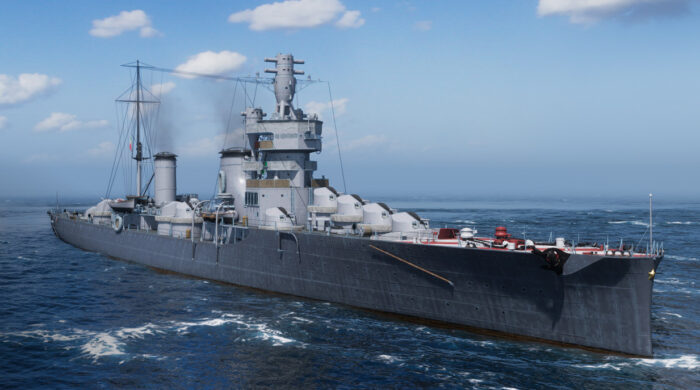
WoW Impression of Alberico Da Barbiano if converted as AA cruiser in the co-belligence.

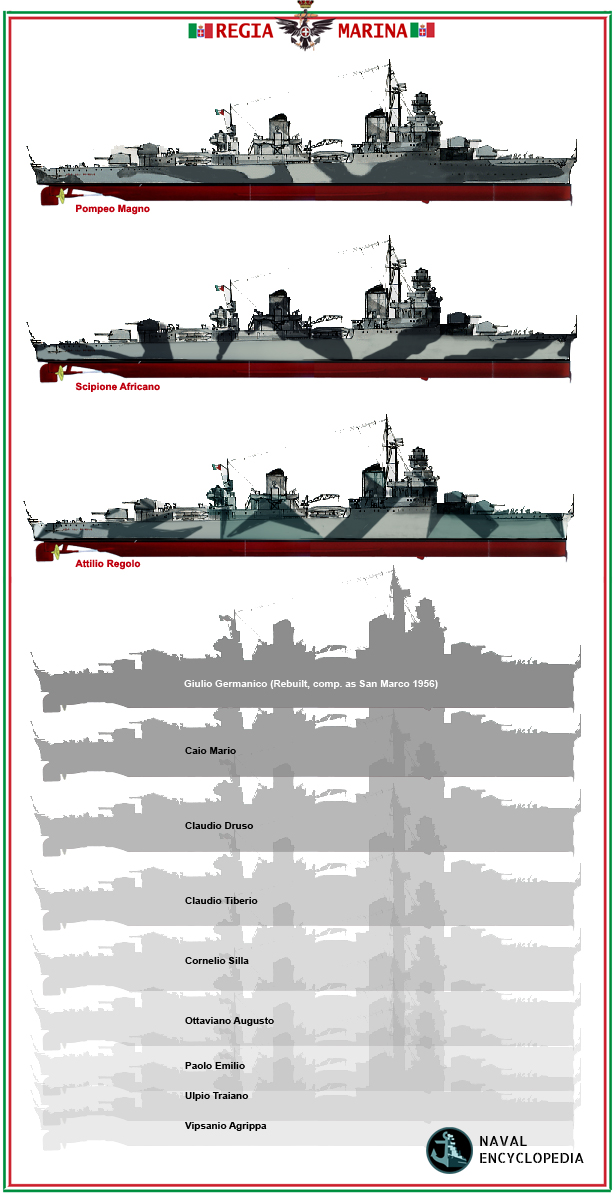

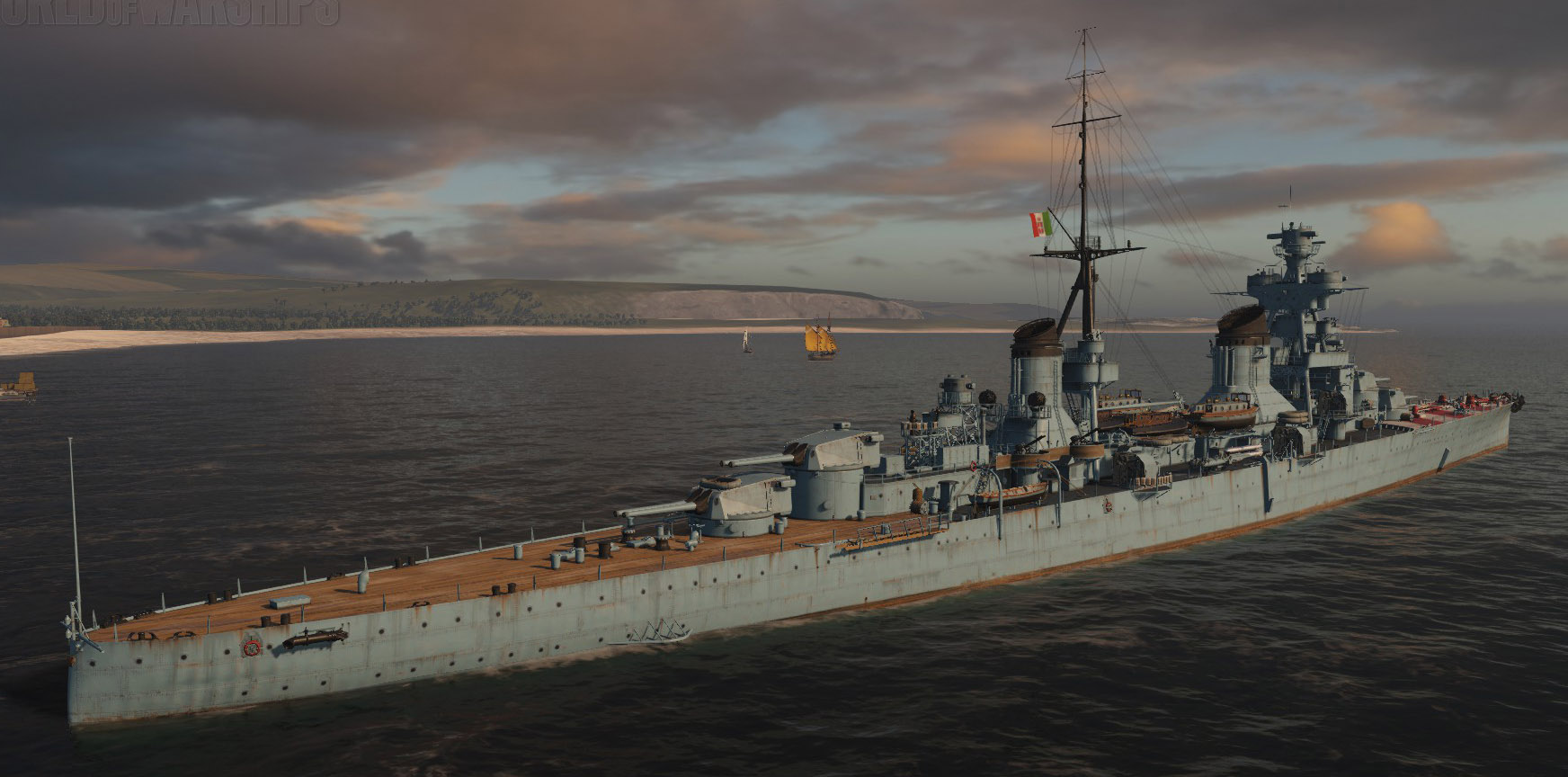
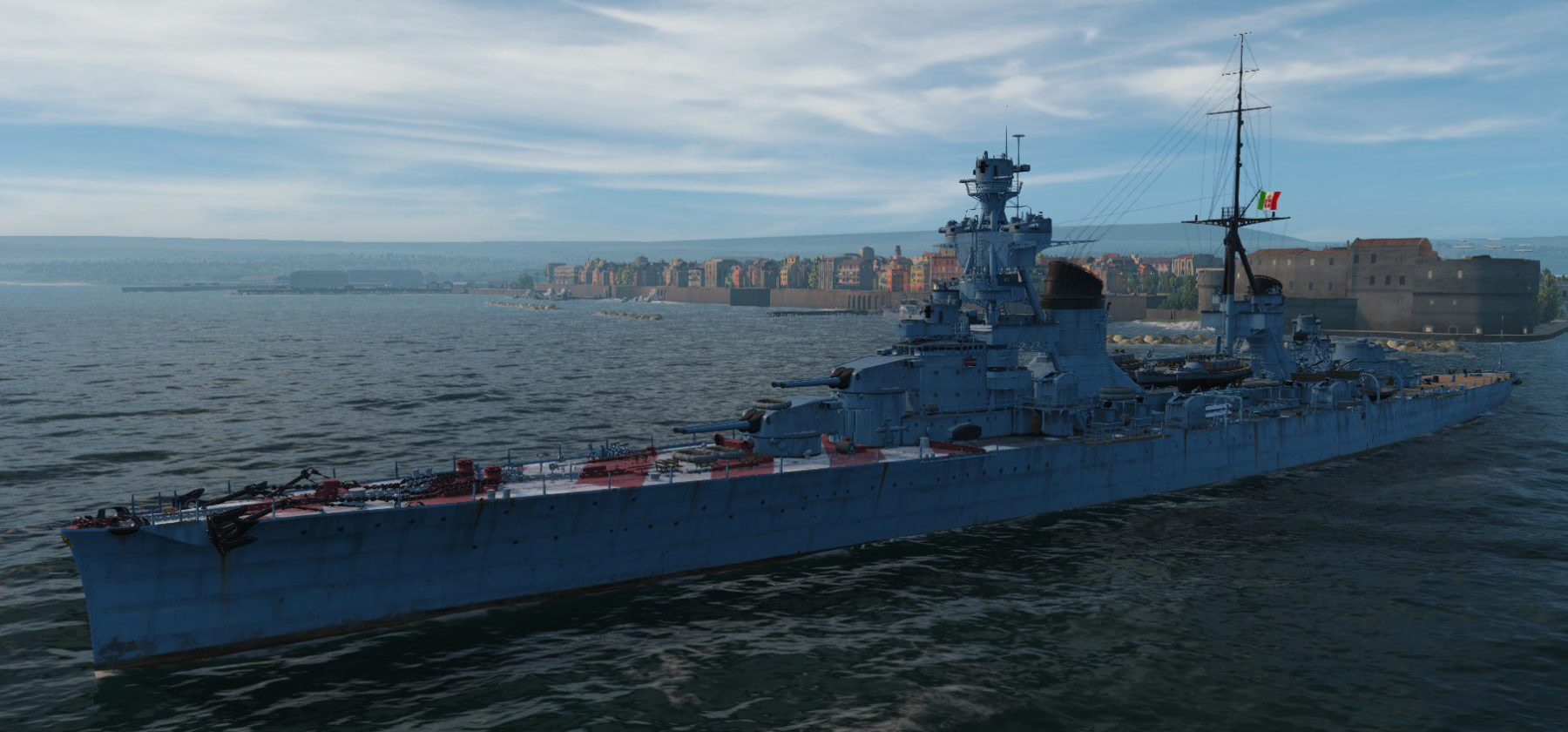


 Latest Facebook Entry -
Latest Facebook Entry -  X(Tweeter) Naval Encyclopedia's deck archive
X(Tweeter) Naval Encyclopedia's deck archive Instagram (@navalencyc)
Instagram (@navalencyc)





 French Navy
French Navy Royal Navy
Royal Navy Russian Navy
Russian Navy Armada Espanola
Armada Espanola Austrian Navy
Austrian Navy K.u.K. Kriegsmarine
K.u.K. Kriegsmarine Dansk Marine
Dansk Marine Nautiko Hellenon
Nautiko Hellenon Koninklije Marine 1870
Koninklije Marine 1870 Marinha do Brasil
Marinha do Brasil Osmanlı Donanması
Osmanlı Donanması Marina Do Peru
Marina Do Peru Marinha do Portugal
Marinha do Portugal Regia Marina 1870
Regia Marina 1870 Nihhon Kaigun 1870
Nihhon Kaigun 1870 Preußische Marine 1870
Preußische Marine 1870 Russkiy Flot 1870
Russkiy Flot 1870 Svenska marinen
Svenska marinen Søværnet
Søværnet Union Navy
Union Navy Confederate Navy
Confederate Navy Armada de Argentina
Armada de Argentina Imperial Chinese Navy
Imperial Chinese Navy Marinha do Portugal
Marinha do Portugal Mexico
Mexico Kaiserliche Marine
Kaiserliche Marine 1898 US Navy
1898 US Navy Sovietskiy Flot
Sovietskiy Flot Royal Canadian Navy
Royal Canadian Navy Royal Australian Navy
Royal Australian Navy RNZN Fleet
RNZN Fleet Chinese Navy 1937
Chinese Navy 1937 Kriegsmarine
Kriegsmarine Chilean Navy
Chilean Navy Danish Navy
Danish Navy Finnish Navy
Finnish Navy Hellenic Navy
Hellenic Navy Polish Navy
Polish Navy Romanian Navy
Romanian Navy Turkish Navy
Turkish Navy Royal Yugoslav Navy
Royal Yugoslav Navy Royal Thai Navy
Royal Thai Navy Minor Navies
Minor Navies Albania
Albania Austria
Austria Belgium
Belgium Columbia
Columbia Costa Rica
Costa Rica Cuba
Cuba Czechoslovakia
Czechoslovakia Dominican Republic
Dominican Republic Haiti
Haiti Hungary
Hungary Honduras
Honduras Estonia
Estonia Iceland
Iceland Eire
Eire Equador
Equador Iran
Iran Iraq
Iraq Latvia
Latvia Liberia
Liberia Lithuania
Lithuania Mandchukuo
Mandchukuo Morocco
Morocco Nicaragua
Nicaragua Persia
Persia San Salvador
San Salvador Sarawak
Sarawak Uruguay
Uruguay Venezuela
Venezuela Zanzibar
Zanzibar Warsaw Pact Navies
Warsaw Pact Navies Bulgaria
Bulgaria Hungary
Hungary

 Bundesmarine
Bundesmarine Dutch Navy
Dutch Navy Hellenic Navy
Hellenic Navy Marina Militare
Marina Militare Yugoslav Navy
Yugoslav Navy Chinese Navy
Chinese Navy Indian Navy
Indian Navy Indonesian Navy
Indonesian Navy JMSDF
JMSDF North Korean Navy
North Korean Navy Pakistani Navy
Pakistani Navy Philippines Navy
Philippines Navy ROKN
ROKN Rep. of Singapore Navy
Rep. of Singapore Navy Taiwanese Navy
Taiwanese Navy IDF Navy
IDF Navy Saudi Navy
Saudi Navy Royal New Zealand Navy
Royal New Zealand Navy Egyptian Navy
Egyptian Navy South African Navy
South African Navy






























 Ukrainian Navy
Ukrainian Navy dbodesign
dbodesign
In the part “Capitani Romani class light cruisers” you are speaking in the text over 135 mm guns. In the specifications below stays: Armament: 4×2 138, 8 x 37 AA, 4×2 20 AA, 2×4 533 mm. That seems a contradiction
Hi Jan, this is 135 mm, fixed. The original article dates back from 2002 and needs serious rewrite.
Best,
Is there any additional info or project regarding the Progetto 986 CL?
not so far..